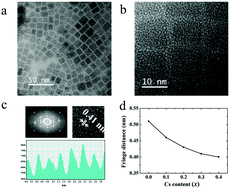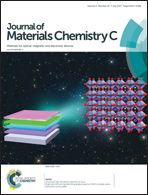Bright and efficient light-emitting diodes based on MA/Cs double cation perovskite nanocrystals†
Abstract
A high quantum yield, tunable band gap, and high color purity of perovskite nanocrystals make this class of materials attractive for electronic and optoelectronic applications in devices including solar cells, photodetectors, and light emitting diodes. Herein, we report for the first time the facile synthesis of perovskite nanocrystals based on (CH3NH3)1−xCsxPbBr3. The emission properties, photoluminescence and stability of the mixed-cation perovskite nanocrystals have been intensively studied, which are significantly related to the content of cesium in the composition. The as-obtained (CH3NH3)1−xCsxPbBr3 nanocrystals were employed as the emission layer in perovskite light emitting diodes, and the device fabricated with the optimized perovskite nanocrystals (Cs doping x = 0.3) showed a maximum luminescence of 24 500 cd m−2, nearly ten-fold higher than those for the previous reported perovskite devices based on MAPbBr3 nanocrystals. This study opens a new avenue for the fabrication of efficient perovskite nanocrystals and provides great potential of developing perovskite LEDs based on mixed-cation perovskite nanocrystals.

- This article is part of the themed collection: 2017 Journal of Materials Chemistry C HOT Papers


 Please wait while we load your content...
Please wait while we load your content...